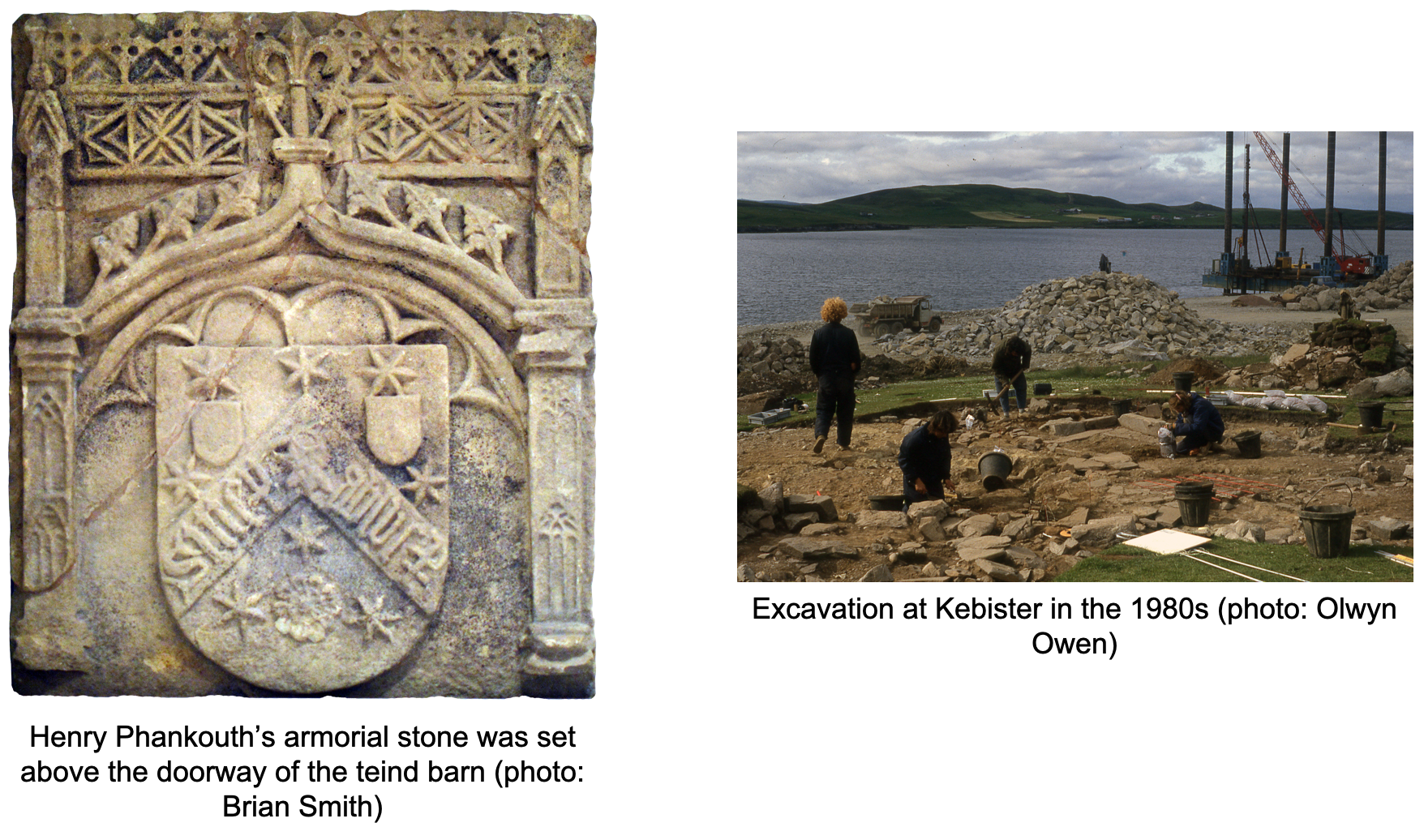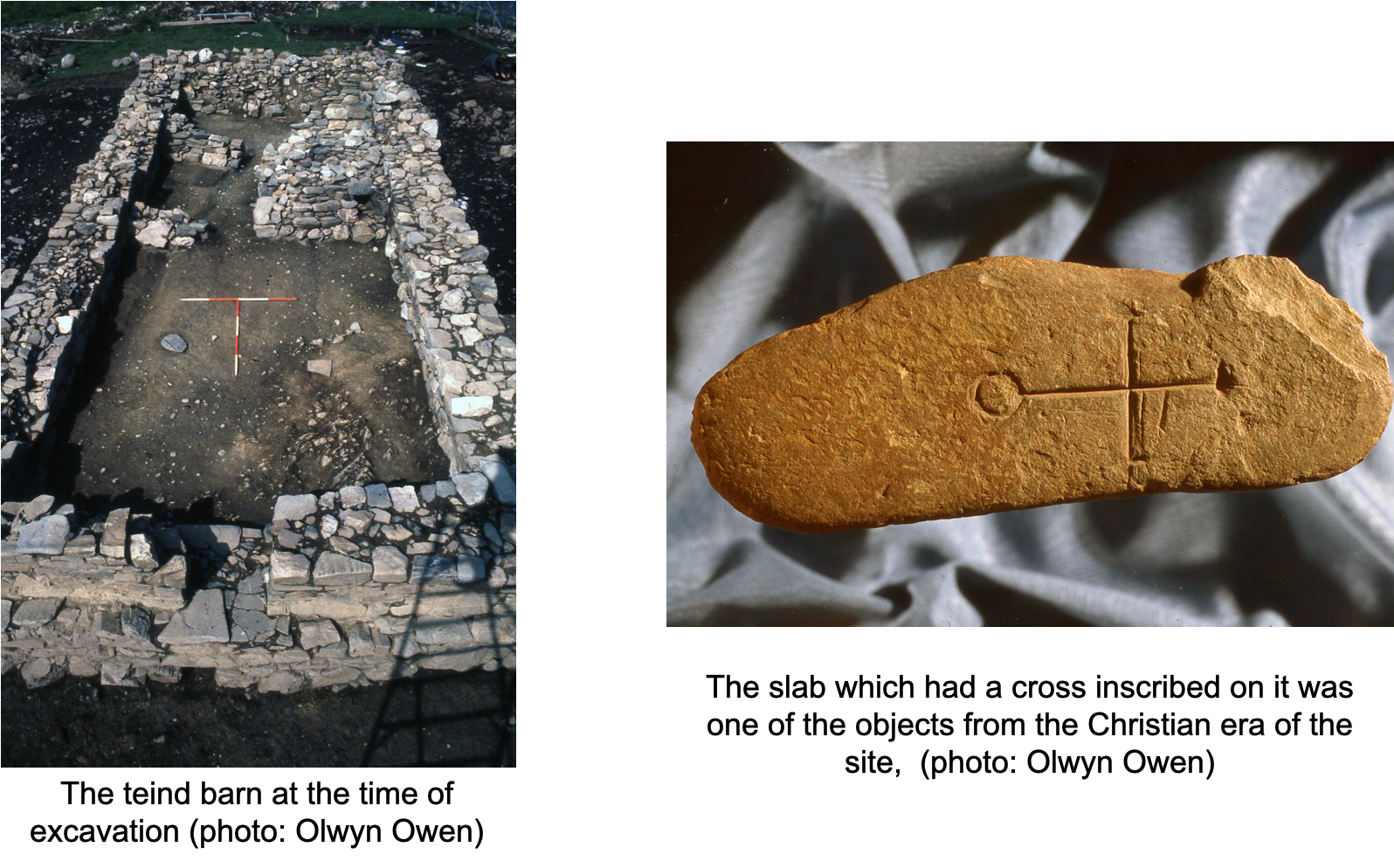Off the Beaten Track 15 – Kebister
Published: 10 July 2020
Archaeologists never know what they are going to find when they begin an excavation, but there have been few surprises at great as that which confronted Olwyn Owen and her team when they dug at Kebister in the 1980s. Olwyn herself is a Viking specialist and Kebister had been identified as an extremely large Viking hall. At the time, it was situated within the foot-print of the rig base which was about to be built at Dales Voe, just outside Lerwick (HU 457 455).
The excavations showed that people had used this spot for at least 4000 years – but any evidence of early Vikings was completely missing.
The enormous building, which is still there today, was not a Viking hall. Instead it was the remains of a large and grand, stone-built teind (tithe) barn. It was built to store the teinds (taxes) and rents which were paid to the Church often in goods, such as cloth, butter or grain. The word “barn” perhaps suggests a rough and ready agricultural building, but this impressive building was a barn only in the sense that it was used for storage. Its coastal location was no accident. People would probably have arrived by boat from all over Shetland.
The Kebister teind barn is unique – it is the only example anywhere in Scotland. It was built in the early 1500s by Henry Phankouth, the Archdeacon of Shetland.
The clue which helped the archaeologists to understand the site was a richly decorated armorial panel which had fallen face down, in front of the door. It had originally been above the door and bore the coat of arms of the illegitimate son of the Bishop of Orkney, Henry Phankouth. He was the Archdeacon of Shetland between 1501-29.

Henry invented his heraldry which reads ‘SINE PAULUSPER’, which means ‘permit me for a little while’. It was a joking reference from a Roman comic play.
One of the highlights found by the diggers was a small gold spangle (a small glittering ornamental object) which had been dropped just outside the door. Perhaps it belonged to Henry Phankouth himself.
The teind barn was falling down by 1561, and a corn-drying kiln was built into the central room, presumably by the inhabitants of the nearby croft, Handigert. The corn-drying kiln continued in use well into the 18th century.
The site held other unexpected secrets too. The teind barn was built over a small timber chapel, possibly Norse (Late Viking), with two 10th-century pine coffins beyond its east end. A cross-incised stone and a piece of exotic green porphyry, part of a portable altar, were also part of this early Christian phase. Curiously, although the archaeologists mapped every inch of the surrounding hillside, they found no sign of an associated longhouse.
Below this were the remains of three Iron Age buildings, dating to the period between 500 BC – AD 400. The latest of them was Pictish in style, with a chain of small, interlinked, circular “rooms”.
Even earlier were the remains of a Neolithic/Bronze Age wooden building, which is also a rare discovery for Shetland. It had a large central hearth. Archaeologists also found cooking pits, burnt mounds, and several cremation burials – all 3-4000 years old.
The walk to Kebister starts northeast of the entrance to the SIC Energy Recovery plant at Rova Head, a little before you get to the Dales Voe base. There is a stile beside the track to a wind turbine on Luggie’s Knowe. Luggie was said to be a wizard who used to pull ready cooked fish out of a hole in the knowe. In consequence, he was convicted of sorcery and burnt at Gallow Hill, Scalloway.
There will soon be a sign board at the gate showing the route, and Lerwick Port Authority have recently put in way markers and stiles to keep you on track. Instead of following the track, bear right across the heathery hill. The walk to the site is relatively short but you will need boots to cross the rough ground.
The walk takes you above and around the area which has been quarried since the rig base was built, following the way markers. On the far side of the quarry there is another stile and from there you can see the site within a fenced area close to the sea. You do not need to cross the Burn of Kebister to reach the site.
The Teind Barn
Today the barn survives much as the archaeologists left it, although it has been fenced. The gate is at the lower end of the site. Lerwick Port Authority was about to put up an interpretive board, designed by Shetland Amenity Trust, just before lock-down. It will be in place shortly.

Handigert.
The croft of Handigert lies on the opposite side of the Burn of Kebister and was also investigated during the archaeological project. It is a fairly typical crofting settlement with three, linked, drystone buildings, which have been altered over time. It may have been established by the Late Norse period, but the majority of the finds shows that it was certainly used between the 17th and 18th centuries.
The crofters almost certainly made use of the, by then derelict, teind barn as a convenient quarry for stone. They also built the corn-drying kiln inside it.
There are traces of a water mill and mill race in a deep geo not far from the croft. The township was surrounded by a hill-dyke which is still very clear on the far (north) side of the burn.
You need to go back the same way that you came, but just before you rejoin the road, if you set off towards the rig base, you will encounter another fenced area.
Here there is a group of six Bronze Age burnt mounds. It is unusual to find such a big group. Two are oval, the other four being more irregular and on the small side for burnt mounds, so it is possible that they were once part of fewer, larger, crescent shaped mounds.
Dr. Val Turner, Regional Archaeologist, Shetland Amenity Trust, July 2020
We hope you have enjoyed this blog.  We rely on the generous support of our funders and supporters to continue our work on behalf of Shetland. Everything we do is about caring for Shetland's outstanding natural and cultural heritage on behalf of the community and for future generations. Donations are welcomed and are essential to our work.
We rely on the generous support of our funders and supporters to continue our work on behalf of Shetland. Everything we do is about caring for Shetland's outstanding natural and cultural heritage on behalf of the community and for future generations. Donations are welcomed and are essential to our work.

